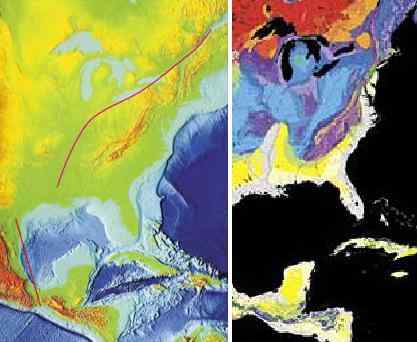
| |
 |
![]()
We have stated that the tearing of the Seaway during the pole shift will allow the New England area to bounce up by 450 feet. The New England area will no
longer be bonded to land to the north of the Seaway so the natural floatation characteristic of the rock is allowed to express itself. How far back along the Seaway
does this bounce travel, and does it affect the northern side of the Seaway? As is known, the rock strata north of the Seaway is a different composition than that to
the south of the Seaway. The ripping of the Seaway has occurred along this boundary because differing rock strata do not bond tightly. Where this is the general
description, the pulling apart of the Seaway is not exactly along the rock strata boundaries, and thus a portion of the lighter rock to the south of the Seaway is found
along its northern edge, and this portion includes Montreal.
Where the Seaway opens into Lake Ontario, it is passing through a pinch of rock that is cohesive both north and south and does not want to rip open. Thus the
finger lakes in New York State, just beyond this pinch, are attempting to rip open where the pinch itself has not yet ripped. Montreal is just prior to this pinch. this
pole shift, the pinch will rip, and rip deeply. This allows Montreal to be relatively unaffected by the tidal sloshing that would otherwise roar up the Seaway, as the
water can drop into the deeper crevasse at the bottom of the Seaway.
However, the rock strata along the northern side of the Seaway, though cohesive with the rock strata in the New England region, will not experience a bounce
because of the deep Seaway rip. The bounce that New England will experience stops on the southern side of the Seaway across from Montreal and should be
prorated along this southern shoreline from this point to the Seaway outlet to determine the degree of bounce for any given area. Where residents of Montreal will
survive the pole shift tidal sloshing, they will be forced to move during the following two years to higher ground when the sea level rises to 675 feet.
ZetaTalk ™

Note Great Lakes commentary.
Note New Madrid commentary.
Note Montreal commentary.